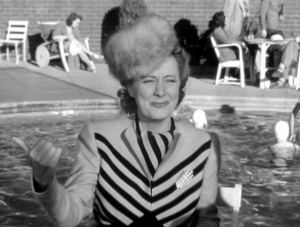I am back in Iowa with my family and we got a beautiful snowstorm yesterday, meaning we are set to have a white Christmas. This also means that it is too cold to romp about outside too much—after all, a Norwegian sweater will only insulate you from so much. In my family this boils down to watching a lot of good, bad, and ugly television.
The other night I was being a couch potato with my father when My Favorite Wife came on. This 1940 romantic comedy features the illustrious talents of Irene Dunne and Cary Grant. Not sure what to expect, I was struck by its quality and depth in comparison to contemporary comedies—especially in regards to its treatment of women.
My Favorite Wife opens up with Grant in a courtroom, speaking with a rather curmudgeonly judge. His wife has been missing for seven years and presumed dead. He is finally getting remarried. The very same day, his missing wife (Dunne) returns home, hoping to pick up where things left off. She reveals herself to him at the hotel where he is supposed to be honeymooning with his new wife, and everything slowly devolves into chaos as he tries to decide what to do. Another wrench is thrown into the mix when Grant learns that Dunne was stranded for seven years on the island with an attractive and athletic man whose identity she attempts to conceal.
The most extraordinary part of this movie is that Dunne’s comedic value is just as important, if not more so, than Grant’s. She is elegant and then engages in physical comedy, putting on silly faces and accents. She gladly pays the judge $50 after making a couple snarky and ribald comments. She is a mother, a jokester, an adventurer. She has romantic freedom, but she knows what she wants and she is willing to fight for it. In short, she is a bona fide, 3D, human being. This was in 1940 and could be deemed ahead of its time. Fast forward to 2013. How often do you see such a well-rounded and hilarious female character?
One of the most annoying stereotypes I hear about women today is that they are not funny. I have been challenged before to “point out a female comic who is actually funny.” Besides the fact that I grew up with one of the funniest people I have ever met, my sister, from whom I steal at least half of my witty comments, I can easily do so within popular culture. Poehler, McCarthy, Kaling, Wiig, Degeneres, Radner, Fey, Rudolph, and Silverman are just a few of the well-known ones. Imagine all the female writers who contribute to shows! Imagine all the female comedians who are not on television!
Women, especially women of color and older or plus-size women, do not have the same comedic opportunities as men because Hollywood is dominated by masculine comedies. The result is that people don’t see women in comedy, and if they do it is often in supporting or sideline roles. Admittedly American film has changed quite a lot in the last sixty years. Attention spans are presumed shorter, so actions are emphasized and characters are less fleshed-out. However, the Bechdel Test shows us that women are rarely featured in a substantial way.
The good news is that Hollywood is Hollywood and not real life. People still engage with one another in profound ways, and men and women make each other laugh every day. It is frustrating to see people diluted down to empty caricatures, but I do believe that we are getting more conscious of it. The important thing is to keep a critical eye and perhaps, occasionally, to remember to laugh.
